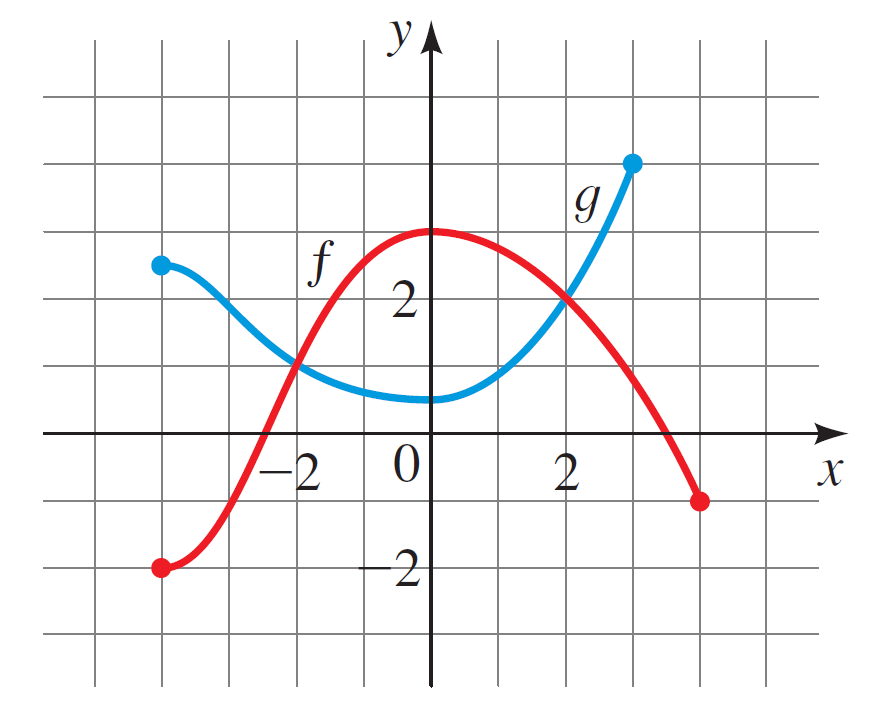Homework 5
Directions:
- Show each step of your work and fully simplify each expression.
- Turn in your answers in class on a physical piece of paper.
- Staple multiple sheets together.
- Feel free to use Desmos for graphing.
Answer the following:
- Draw a coordinate plane and graph the points $(1,2), (2, -1), (-3, -4)$ and $(4, -3)$.
- Sketch a graph of the following equations by picking points:
- $x - y = 1$
- $y = \sqrt{x}$
Hint Pick perfect squares for $x$, i.e. $1, 4, 9, \dots$ - $y - x = -2$
- $x^2 - y = 1$
- $-\lvert x \rvert - 1 + y = 0$
- Find the $x-$ and $y-$ intercepts of the following equations.
- $y = x + 6$
- $y = x^2 - 4$
- $y = -\sqrt{16 - x^2}$
- Draw two lines in the coordinate plane; one with negative slope and one with positive slope.
- Find the equation of a line that passes through $(4, 4)$ and $(0, 2)$. Write your answer in slope-intercept form.
- Find the equation of a line that passes through $(-2, 5)$ and $(0, 2)$. Write your answer in slope-intercept form.
- Find the equation of a line with slope $-3$ and passes through the point $(1,1)$. Write your answer in slope-intercept form.
- Find the equation of a vertical line that passes through $(-2, 4)$.
- Find the equation of a horizontal line that passes through $(-3, -3)$.
- Suppose I have an expression $f(x)$ and I find two different inputs that give the same evaluation. In particular, I find that $x = 2$ and $x = 3$ gives $f(2) = f(3)$. Is $f$ a function?
- Suppose I have an expression $f(x)$ and I find one input which gives two different evaluations. In particular, I find that $x = 2$ spits out $f(2) = 5$ and $f(2) = 3$. Is $f$ a function?
- Write down two examples of functions in your daily life.
- Suppose your friend was given a function \[f(x) = x^2 - 3\] and they are asked to find $f(x + h) - f(x)$. Your friend ends up writing \[f(x + h) - f(x) = x^2 - 3 + h - x^2 - 3\] Identify the two mistakes that were made.
- Let $f(x) = x^2 - x + 1$. Evaluate and simplify the following:
- $f(1)$
- $f(a)$
- $f(-a)$
- $f(x + h)$
- $\dfrac{f(x + h) - f(x)}{h}$
- Let $f(x) = \dfrac{1}{x}$. Evaluate and simplify the following:
- $f(-1)$
- $f(x + h)$
- $\dfrac{f(x + h) - f(x)}{h}$
- Let $f(x) = 2x^2 - x$. Evaluate and simplify the following:
- $f(0)$
- $f(x + h)$
- $\dfrac{f(x + h) - f(x)}{h}$
- Suppose $f$ is a function. What two types of numbers do you need to remove when finding the domain?
- Find the domain of the following functions:
- $f(x) = \dfrac{1}{x - 1}$
- $f(x) = \dfrac{1}{x^2 + 3x + 2}$
- $f(x) = \dfrac{x^2 - 2x + 1}{x - 1}$
- $f(x) = \dfrac{x^2}{(x^2-1)(x^2-4)}$
- $f(x) = \sqrt{2x - 1}$
- Find the domain of the following functions:
- $f(x) = \dfrac{1}{\sqrt{2x - 1}}$
- $f(x) = \dfrac{1}{x\sqrt{2x - 4}}$
Hint Use the zero product property when setting denominator to zero. - $g(x) = \sqrt{x-2} - \dfrac{2x}{\sqrt{-x + 3}}$
- Let \[f(x) = \begin{cases} 3x + 2 & x \geq 2 \\ x^2 - x & x < 2\end{cases}\] Evaluate the following:
- $f(0)$
- $f(1)$
- $f(2)$
- $f(3)$
- $f(4)$
- Let \[f(x) = \begin{cases}-1 & x < -1 \\ x & -1 \leq x \leq 1 \\ -1 & x > 1\end{cases}\] Evaluate the following:
- $f(-2)$
- $f(-1)$
- $f(0)$
- $f(0.99)$
- $f(1)$
- $f(2)$
- Sketch a graph on the coordinate plane for the following functions using the table. Feel free to verify your graphs with Desmos.
- $f(x) = 1-x^2$
- $g(x) = x^3 + 1$
- $f(x) = \begin{cases} -x - 1 & x \leq 1 \\ x + 1 & x > 1\end{cases}$
- $f(x) = \begin{cases} x & x > 1 \\ x^2 - 1 & x \leq -1\end{cases}$
- $f(x) = \begin{cases} 1 & x \geq 2 \\ -1 & x < 2 \end{cases}$
- $g(x) = \begin{cases} x & x > 0 \\ 1 & x = 0 \\ -2x + 3 & x < 0 \end{cases}$
- Draw a curve in the plane that is not the graph of a function.
- Is this expression a function? Why or why not? \[f(x) = \begin{cases}x^2 - 3 & x \geq 0 \\ -x - 4 & x \leq 0\end{cases}\]
- Given the two functions $f$ and $g$
- What is $f(0)$?
- What is $g(3)$?
